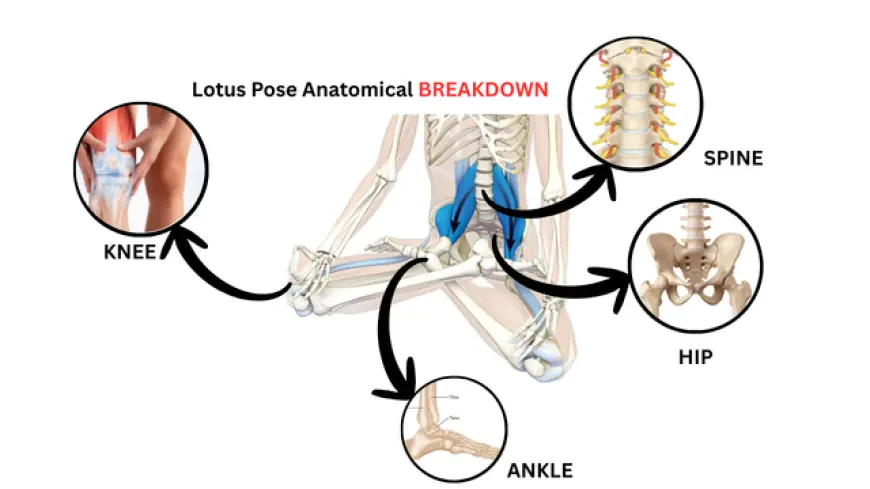Lotus Pose Anatomy: Muscles at Work and Key Benefits in Yoga
Lotus Pose Anatomy: Muscles at Work and Key Benefits in Yoga

Lotus Pose, or Padmasana, is one of yoga’s most iconic postures. Known for its deep meditative quality, it symbolizes stability, grounding, and openness. But behind its serene appearance lies a fascinating interplay of muscles and joints that allow the body to fold gracefully into this posture. Understanding Lotus Pose anatomy not only deepens your practice but also helps prevent strain and injury.
Muscles at Work in Lotus Pose
Lotus Pose is primarily a hip-opening posture. It requires both mobility and stability, engaging multiple muscle groups to create the shape:
1. Hip Rotators
-
Gluteus maximus, medius, and minimus
-
Piriformis and deep lateral rotators
These muscles externally rotate the hips, allowing the thighs to open outward so the feet can rest on the opposite thighs.
2. Hip Flexors
-
Iliopsoas (psoas major and iliacus)
-
Sartorius
The hip flexors assist in drawing the knees toward the ground while maintaining an upright spine. Sartorius, known as the “tailor’s muscle,” plays a unique role in both flexing and externally rotating the hip.
3. Adductors
-
Adductor longus, brevis, and magnus
-
Gracilis
Though Lotus Pose opens the hips, the adductors work eccentrically to stabilize the thighs and prevent overstretching.
4. Spinal Erectors and Core
-
Erector spinae
-
Transverse abdominis
-
Multifidus
These muscles maintain a tall, elongated spine, which is crucial for the meditative benefits of the pose.
5. Knee Stabilizers
-
Quadriceps (especially vastus medialis)
-
Hamstrings
While the hips bear most of the movement, the knees act as hinges and must remain supported by strong surrounding muscles to avoid strain.
Key Benefits of Lotus Pose
Practicing Lotus Pose regularly can bring profound physical and mental benefits:
1. Improves Hip Mobility
The deep external rotation and flexion help release tight hips, increasing flexibility and circulation.
2. Strengthens Postural Alignment
By engaging the spine and core, Lotus Pose encourages upright posture and strengthens back muscles.
3. Supports Meditation and Breathing
The stable base and lifted spine create optimal conditions for pranayama and meditation, allowing deeper, more expansive breathing.
4. Grounding and Calming
The symmetry and stillness of Lotus Pose promote a sense of balance and inner calm, making it a favorite for mindfulness practices.
5. Energizes the Body
In yoga philosophy, Padmasana is said to activate energy channels (nadis) and stimulate chakras, fostering vitality and mental clarity.
Practicing Lotus Pose Safely
Because Lotus Pose requires significant hip flexibility, it should be approached gradually. Warm up with hip-openers like Bound Angle Pose (Baddha Konasana), Pigeon Pose (Eka Pada Rajakapotasana), and Half Lotus before attempting full Lotus. Always prioritize comfort over forcing the shape—healthy alignment is more important than achieving the “perfect” pose.
Final Thoughts
Lotus Pose anatomy reveals how much strength, flexibility, and awareness this iconic posture demands. It’s more than just a meditative seat—it’s a whole-body experience that unites muscle engagement, breath, and focus. By understanding the muscles at work and practicing with care, you can unlock both the physical and spiritual benefits of Lotus Pose.
What's Your Reaction?
 Like
0
Like
0
 Dislike
0
Dislike
0
 Love
0
Love
0
 Funny
0
Funny
0
 Angry
0
Angry
0
 Sad
0
Sad
0
 Wow
0
Wow
0

















































